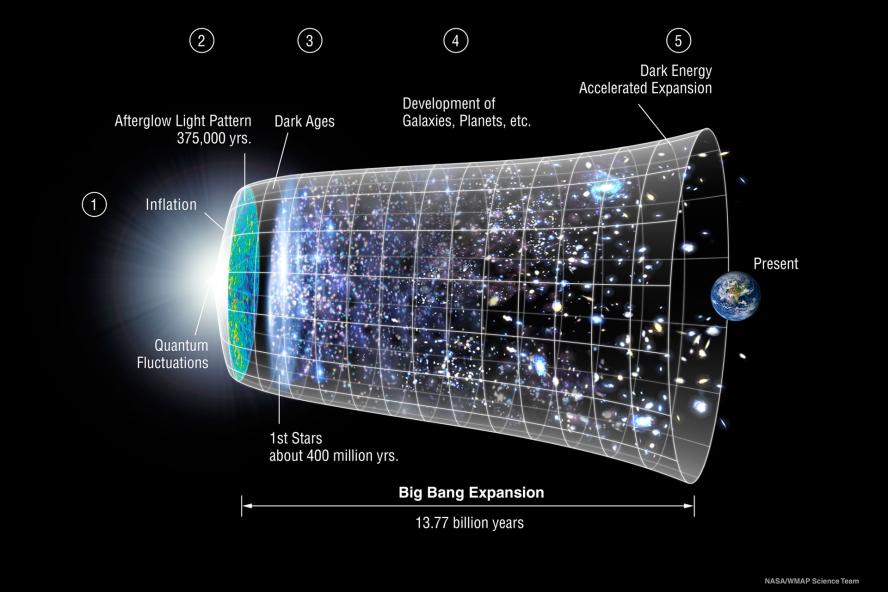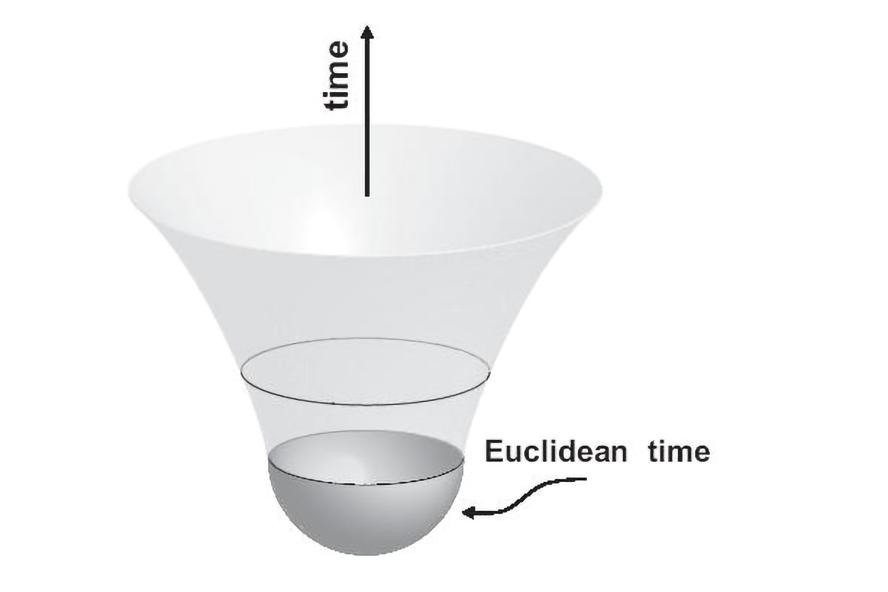Research
The Tufts Institute of Cosmology investigates a wide range of topics in theoretical physics and cosmology, ranging from high-energy cosmic rays, cosmic strings and other topological defects, energy conditions in general relativity, negative energies and closed time-like curves, quantum fluctuations in the presence of gravitation, cosmological inflation, eternal inflation and the multiverse, dark energy, anthropic selection, quantum cosmology, and string cosmology, to name some areas of concentration. Aspects of these topics are described below. See a list of papers by Institute of Cosmology members.

The wiggly tube shows the shape of a cosmic string taken from a simulation, at a particular moment in time. This string is about to emit several bursts of loops. The color of the string shows its rate of motion, red being very close to the speed of light and blue being slowest, and the white arrows show the direction and velocity of selected string segments.
Each colored arrow represents the emission of one loop. The starting point of the arrow is the point where the loop breaks off the long string (or a predecessor loop). The width of the arrow is proportional to the size of the loop, and the length and direction of the arrow show the loop velocity. In general the larger loops move more slowly, and some of the smallest loops travel at nearly the speed of light. The color of the loop represents the time of emission: the dark blue loops are just about to be emitted, while the red loops will be emitted last. Starting from the position shown, the string travels toward the right, sweeping across the field of view and emitting several hundred loops as it passes.
Cosmic Defects
Unified theories of particle interactions permit stable solutions referred to as "defects." If big bang evolution cooled the universe through a phase transition breaking such unified symmetries, then it is possible that cosmological defects were formed. These could leave signatures in the form of gravity waves, cosmic microwave background anisotropies, high-energy cosmic rays, etc., thus informing us of details of high-energy physics otherwise inaccessible to experiment. Recent research has included studying the evolution and observational effects of cosmic string and superstring networks.
Cosmic strings are astronomically long, microphysically thin filaments which may exist in our universe. When strings intersect themselves, they can reconnect and so chop off moving loops, which may be observable sources of cosmic rays or gravitational waves.
The image to the left shows loops being emitted from a fast-moving piece of cosmic string. This picture won second place in the Illustrations category in the 2011 Visualizing Research@Tufts Awards.

Inflation
The initial conditions for hot big bang evolution were probably established during a period of false-vacuum energy domination in the very early universe, called "inflation." Aside from establishing the homogeneity and isotropy of the universe, inflation leaves tell-tale signatures in the cosmic microwave background, some of which have already been observed. Yet, a particle-physics motivated model of inflation remains elusive. Recent work at the Institute has included studying string-theory inspired models of inflation.

The Multiverse
Cosmological inflation is generically eternal: although inflation ends in some regions of spacetime, it persists indefinitely elsewhere. In this picture, our "universe" is one thermalized pocket among an infinite set of others, collectively referred to as the "multiverse." If the fundamental theory permits a set of vacuum solutions -- as occurs for example in the string landscape -- then different pocket universes may have different low-energy laws of physics. This picture has tantalizing consequences for cosmology. For example, it offers perhaps the most plausible explanation for the observed non-zero cosmological constant (dark energy). This explanation involves anthropic selection: the string landscape contains vacua with a wide range of effective cosmological constants, but galaxies -- and hence observers like us -- can only arise when the cosmological constant is very small. Recent work has focused on how to define a probability measure over the diverging spacetime volume of an eternally inflating multiverse, and on what predictions can be made for the values of observable cosmological parameters.

Negative Energies
Is it possible to create a stable wormhole, or to travel faster than light or backward in time? General relativity could produce spacetimes with such exotic possibilities, if given the right distribution of matter and energy to act as a source. But all such exotic phenomena depend on sources with negative energy density. Negative energies can arise in quantum mechanics, for example in the Casimir effect, but their properties are strongly constrained. Recent research has included quantum inequalities, which restrict the duration and magnitude of negative energy densities, and studying the validity of certain "energy conditions" which, if always obeyed, would imply that necessary sources for such exotic phenomena can never arise.

Quantum Cosmology
Even though inflation may be eternal to the future, it cannot be eternal to the past. A theorem, proved by Vilenkin in collaboration with Arvind Borde and Alan Guth, shows that eternally inflating spacetimes are incomplete to the past, indicating that inflation must have had a beginning. What kind of a beginning could it be? A very intriguing possibility is that a small closed universe filled with a high-energy false vacuum could spontaneously materialize by tunneling quantum-mechanically from "nothing" -- a state with no classical space and time. The newly born universe immediately starts to inflate, and its subsequent evolution is along the lines of the inflationary scenario.
Quantum nucleation of the universe is illustrated in the picture on the left. This picture also appears in the logo of the Tufts Institute of Cosmology.

Philosophy of Cosmology
To make sense of probabilities in a very large or infinite universe requires assuming that we are typical among all observers. Otherwise we could belong to a very unusual civilization whose observations have, by chance, given us incorrect information about the real world. But such anthropic reasoning gives rise to a host of philosophical issues. For example, the same ideas might allow one to infer that our race will soon be extinct so that we ourselves live at a typical time in human history instead of near the beginning, the so-called "doomsday argument".
In an infinite universe, everything happens an infinite number of times, so what does it mean to say that one thing is more likely than another? Such problems are addressed by the use of a measure, but how do we decide which measure to pick? Many measures have been proposed, but all have counterintuitive properties.
Members of the Institute sometimes work on these issues, which lie on the boundary between physics and philosophy.
Links of Interest
- E-print Archives
- SLAC INSPIRE Archive
- Hyperspace at AEI (formerly MacCallum's List)